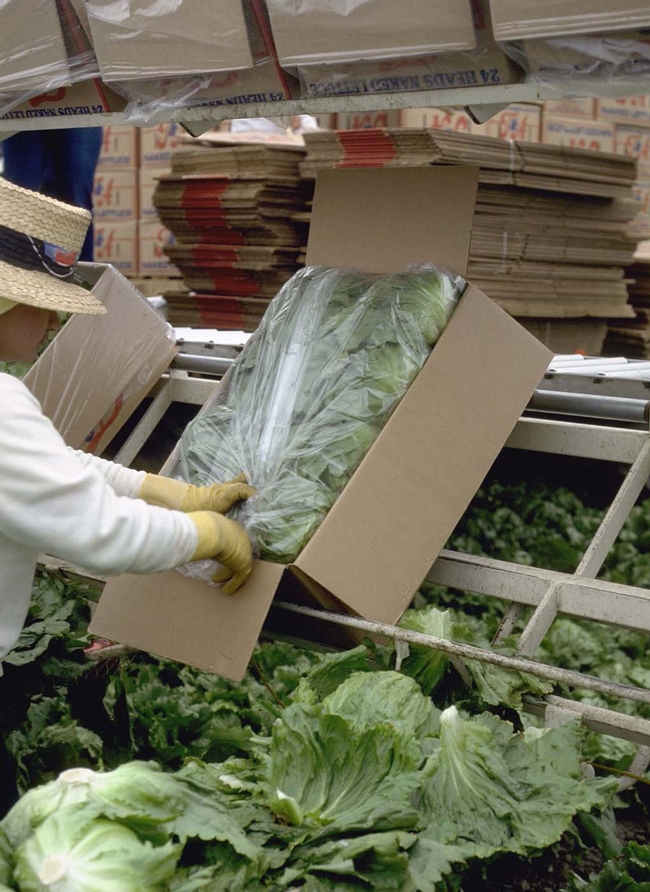Posts Tagged: food safety
No need to pass on the Caesar's salad
At least 58 people have been sickened, and two — one in California and one in Canada — have died because they contracted E. coli O157:H7 in November and December, believed to be related to eating romaine lettuce or other leafy greens. In the United States, the U.S. Centers for Disease Control has linked at least 17 reports of illness in 13 states to the outbreak.
That has many people passing on Caesar's salad. But UC Cooperative Extension specialist Trevor Suslow said it is unlikely that romaine now at grocery stores is contaminated, reported Bob Rodriguez in the Fresno Bee.
"It's not going to last that long, it's gone," Suslow said.
The CDC is conducting whole genome sequencing on samples of bacteria making people sick in the U.S. and Canada to determine whether they are related. Preliminary results show the type of E. coli is closely related genetically, the CDC reported.
Food safety technology has improved in leaps and generations
Food safety technology has improved significantly in recent years as molecular microbiology, electronic data sharing and analysis of matching genetic relatedness has advanced, reported Samantha Masunaga in the Los Angeles Times. The comments are from UC Agriculture and Natural Resources Cooperative Extension specialist Trevor Suslow, who is featured in a Q&A about the food safety problems suffered by the fast-casual restaurant chain Chipotle Mexican Grill.
"We've got a long way to go still to make the level of compliance more uniform, better, cheaper, and some of it is simply lack of science and lack of knowledge about the specific link between practices, pathogen biology, exposure," Suslow said.
He believes the food at Chipotle is not necessarily safer now that changes have been made at the popular restaurants.
"I know from personal contact that many similar fast-casual and fast-food restaurants are reassessing their internal operations and their supply chain management," Suslow said. "I guess we'll wait and see how their consumer base responds if they implement the practices of trying to do treatments that change the fresh nature of their components that might not normally be cooked."
UC ANR to help growers comply with new food safety rules
While the U.S. Food and Drug Administration puts the finishing touches on the latest version of the Food Safety Modernization Act, UC Agriculture and Natural Resources advisors are planning how they will help farmers comply with new provisions, reported Taylor Hillman on AgNetWest.com.
Hillman spoke to Mary Bianchi, the director of UC ANR Cooperative Extension in San Luis Obispo County. She said most growers already have many components the act requires, such as their nutrient management plan and their irrigation plan.
"It's a matter of understanding what additional information they might need to be documenting on an ongoing basis and putting all the information together in one place," Bianchi said.
The FDA's Food Safety Modernization Act will likely require producers to take part in eight hours of continuing education on food safety, so UC ANR is making plans to offer the training.
"The Produce Safety Alliance from Cornell has worked with many extension people across the country to draft a curriculum that includes information we consider to be important for growers across the United States," Bianchi said. "That needs to be adapted for our growers here in California, of course, and we'll work with that information and hopefully with other agricultural organizations to make sure that our growers have access to the education that they need to comply."
Food irradiation possible solution for food safety failings
Irradiating meat can reduce Salmonella and Camphylobacter levels to almost zero, making it safer for consumers who aren't handling raw meat properly, according to a UC consumer behavior and food science expert who was quoted in Food Quality New. However, the practice is not gaining traction.
Christine Bruhn, UC Cooperative Extension specialist in the Department of Food Science and Technology at UC Davis, says the need for increased meat irradiation was revealed in a recent study. She and her staff analyzed video footage of 120 people preparing a self-selected chicken dish and salad in their home kitchens. Bruhn reported that 65 percent did not wash their hands before starting the meal and 38 percent didn't do so after touching the raw chicken. Other food preparation practices that increase the likelihood of causing food-borne illness were also observed.
"People don't realize what they are doing with their hands, especially after touching raw poultry," Bruhn said. "To take an example, if you had honey poured on the chicken, you touch the honey and touch the cupboard and the door handle, it is spread all over everything and cross contaminates the kitchen."
Prompted by the findings, a number of organizations are launching an educational campaign to increase consumer knowledge about safe food preparation practices in the home. In addition, Bruhn recommends wider use of irradiation of meat.
She said meat vendors are concerned consumers will reject irradiated food, a sentiment she considers a "cop out."
"Supermarkets are the gatekeepers. It is not the consumer blocking it," Bruhn said.
UC Riverside calculations help demonstrate food safety
Robert Krieger, UC Cooperative Extension specialist in the UC Riverside Department of Entomology, calculated that a child could consume hundreds or even thousands of servings of many popular fruits and vegetables in one day and still not experience any negative health effects from pesticide residues.
To make the Pesticide Residue Calculator, Krieger analyzed the highest residue levels found on fruits and vegetables by the USDA and calculated the number of servings which could be eaten in one day without any negative health effects from the pesticide residues that may be present, according to a news release by the Alliance for Food and Fiber.
"At the end of the day, I think it's the responsibility of all parents and all adults to encourage children to eat their fruits and vegetables to help ensure they have long and productive lives," said Carl Keen, professor in the Department of Nutrition at UC Davis.
The Alliance for Food and Farming is a non-profit organization that works to provide a voice for farmers to communicate their commitment to food safety and care for the land, according to the organization's website.

The goal of the Pesticide Residue Calculator is to assure parents it is safe to serve children as many fruits and vegetables as they will eat, whether they are conventional or organic.




